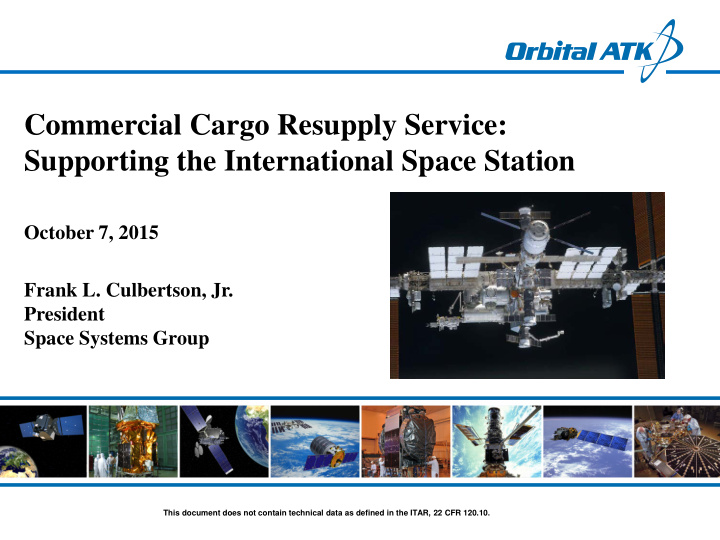



Commercial Cargo Resupply Service: Supporting the International Space Station October 7, 2015 Frank L. Culbertson, Jr. President Space Systems Group This document does not contain technical data as defined in the ITAR, 22 CFR 120.10.
The Commercial Model In 2005, NASA was charged with the task of “stimulating commercial enterprise in space by asking American entrepreneurs to provide innovative, cost-effective commercial cargo and crew transportation services to the International Space Station” From 2006 to 2013, under the Commercial Orbital Transportation Services (COTS) program, NASA acted as both an investor and advisor Under this Program and in less than 5 years, Orbital ATK developed and flew the “Antares” medium class rocket and the “Cygnus” advanced maneuvering space vehicle, designed to meet the stringent safety requirements for International Space Station operations. Commercial Services were then provided under NASA’s follow-on Commercial Resupply Services (CRS) contract 2
Commercial Space Today: Cargo Resupply Mission to ISS Antares Fueling at Pad 0A Antares Liftoff Cygnus Rendezvous With ISS 3
Cargo Services Provided to the ISS Cargo Up Cargo Down 4
Cygnus Delivers for NASA! Demo Mission – Fully Successful 700kg Delivered 1000kg Taken Away Orb-1 Mission – Fully Successful 1465kg Delivered 1461kg Taken Away Orb-2 Mission – Fully Successful 1664kg Delivered 1650kg Taken Away Orb-3 Mission – Loss of Mission 2290kg Was Manifested In three missions, Cygnus has delivered more than 8360 lbs of pressurized cargo 5
CRS Return To Flight Planning Orbital ATK Is Implementing a Return to Flight Plan That Delivers Cargo to the ISS by December 2015 The Orbital ATK Plan: Return Antares to Flight in early 2016 Using New, In- production RD-181 Engines Purchase Launch Services from Atlas V to Launch Cygnus during the Antares Down-time Cygnus was designed to be compatible with multiple launch vehicles Integration with Atlas V going very smoothly and scheduled to launch in early December 2015 Updated Pressurized Cargo Module (PCM) configuration of internal structure allows for higher cargo loads Approximately 3500 kg manifested on OA-4 6
OA-4 Preparations Underway – Pressurized Cargo Module at KSC 7
Ready to Continue Commercial Cargo Services to the ISS 8
ISS Enables Commercialization in LEO With the extension of the ISS to 2024, NASA has at least 9 more years to accomplish its goal to enable: The development of a commercial market for human spaceflight in LEO Human spaceflight beyond LEO through technology/systems demonstrations NASA, FAA and other Government agencies need to take steps now to promote, protect and establish commercial activities in LEO Legislation and Policies Simplification of ITAR requirements Funding Protection of Intellectual Property generated from Commercial Activities Developing agreements for commercial transportation and the use of NASA astronauts supporting commercial operations 9
Orbital ATK’s Roadmap for ISS Commercialization Increased commercial transportation services for commercial ISS experiments using Cygnus. This augments NASA and National Lab ISS Utilization. Augmentation of ISS Laboratory equipment with commercially owned and operated equipment Augmentation of the ISS with a complete commercial module for specialized experimentation Free Flyer Commercial Module Independent of ISS 10
Possible Long Term Future for ISS Commercialization ISS could transition from a Government operated facility to a Government owned – contractor operated facility Commercial Contractors (Domestic and potentially international) would operate the ISS NASA would have access to the ISS for specific activities performed by their astronauts All transportation and resupply would be managed by the commercial operator A large subset of the total research conducted on the ISS would be performed by commercial astronauts Enhancement or Replacement of ISS elements could use commercially developed and manufactured habitation modules 11
Summary NASA can help invigorate the commercial LEO market through – Restructuring of requirements to accommodate commercial utilization Streamlining of processes (i.e. safety process) Funding opportunities to prime the commercialization pump − Anchor tenant − COTS model Accommodate commercial utilization outside of National Lab − Opens new markets Large Scale Commercial Utilization still waiting on the “killer app” Use of commercial practices and contracting approaches is the most cost effective way to provide services in space COTS model can be applied to other NASA activities beyond LEO 12
Commercial Approach Can Also be Applied From ISS to Mars and Everywhere In-Between I nflatable Mars Structure Logistics Dem o Resupply Life Mission Support Free Free-Flyer Dem o Flyer Deep Space Rendezvous Lab Radiation & Docking Shield Dem o I SS Dem o Test bed Deep Space Habitat Asteroid Mission Exploration I SS Subsystem I SS Lab/ Prop Testing Resupply Module Mission Satellite Lunar Servicing Logistics HI AD Resupply Space Entry Mission Tug Dem o 13 13
Recommend
More recommend